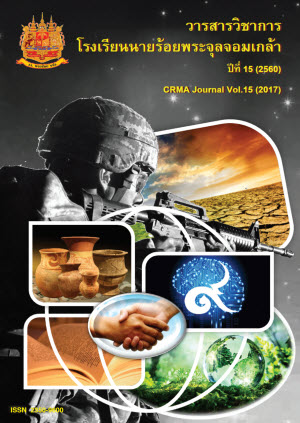การประยุกต์ใช้เทคโนโลยีภูมิสารสนเทศศึกษาการเปลี่ยนแปลงใช้ประโยชน์ที่ดินบริเวณพื้นที่ชายแดนไทยกัมพูชา
Main Article Content
บทคัดย่อ
งานวิจัยนี้มีวัตถุประสงค์เพื่อศึกษาการใช้ประโยชน์ที่ดินและการเปลี่ยนแปลงการใช้ประโยชน์ที่ดินบริเวณพื้นที่ชายแดนไทยกัมพูชาบริเวณปราสาทพระวิหาร ทำการจำแนกชนิดการใช้ประโยชน์ที่ดินด้วยวิธีการแปลตีความด้วยสายตาจากข้อมูลภาพจากดาวเทียม LANDSAT-5, LANDSAT-8, และ THAICHOTE ที่บันทึกภาพในปี พ.ศ.2548 พ.ศ.2553 และ พ.ศ.2558 และวิเคราะห์การเปลี่ยนแปลงการใช้ประโยชน์ที่ดินด้วยวิธี Comparison Matrix ผลการศึกษาการเปลี่ยนแปลงการใช้ประโยชน์ที่ดินของประเทศไทยในช่วงปี พ.ศ.2548-2558 พบว่า พื้นที่ยางพารามีแนวโน้มเพิ่มขึ้นมากที่สุด 128.83% ในปี พ.ศ.2558 รองลงมาได้แก่ พื้นที่นาข้าว, ปาล์มน้ำมัน, พื้นที่ถาง, และชุมชน หมู่บ้านและสิ่งก่อสร้าง ตามลำดับนอกจากนี้พบว่าพืชไร่มีแนวโน้มลดลงมากที่สุด โดยพื้นที่ที่ลดลงส่วนใหญ่ถูกเปลี่ยนไปเป็นพืชเศรษฐกิจชนิดอื่น ได้แก่ ยางพารา, นาข้าว, ปาล์มน้ำมัน และพืชสวนและไม้ผล ในส่วนของพื้นที่ป่าธรรมชาติ พบว่าป่าดิบ ป่าเบญจพรรณ และป่าเต็งรังมีแนวโน้มลดลงเล็กน้อย เนื่องมาจากการบุกรุกทำลายและส่วนใหญ่ถูกเปลี่ยนแปลงไปเป็นพื้นที่เกษตรกรรม เช่น ยางพารา พืชไร่ และนาข้าว การเปลี่ยนแปลงการใช้ประโยชน์ที่ดินในประเทศกัมพูชา ในช่วงปี พ.ศ.2548-2558 พบว่า พื้นที่ป่าเบญจพรรณและป่าดิบมีแนวโน้มการลดลงมากที่สุด โดยลดลง 53.29% และ 32.38% ตามลำดับในปี พ.ศ.2558 โดยพื้นที่ที่ลดลงส่วนใหญ่ถูกเปลี่ยนไปเป็นพืชไร่ พื้นที่ถาง และนาข้าว ตามลำดับ และพบว่าพื้นที่ชุมชน หมู่บ้าน และสิ่งก่อสร้าง เพิ่มขึ้นอย่างมากในปี พ.ศ.2558
Article Details
ผลงานที่ได้รับการตีพิมพ์ ถือเป็นลิขสิทธิ์ของวารสารฯ
เอกสารอ้างอิง
Aspinall,R. and Hill M.J., 2008. Land Use Change: Science, Policy and Management. Boca Raton: CRC Press.
Young, A. , 1998. Land Resources. Cambridge: Cambridge University Press.
Prunier, G., 1995. The Rwanda Crisis, 1959-1994: History of a Genocide. London: Hurst.
กระทรวงการต่างประเทศ, 2557. คำพิพากษาของศาลโลก. [Online] http://www.mfa.go.th,
Swann D., 1999. “Military applications of GIS” In P.A Longley, and others, ed., New Developments in Geographical Information Systems: Principles, Techniques, Management and Applications, pp.889- 899. 2nd ed. New York: John Wiley&Son
คณะทำงานจัดทำแผนแม่บทการพัฒนาระบบภูมิสารสนเทศกองทัพบก กองทัพบก. 2559. แผนแม่บทการพัฒนาระบบภูมิสารสนเทศ กองทัพบก ปี 2559-2561. กรุงเทพฯ: กองทัพบก.
Bank, N. and Rogers, T., 2006. Surveying Technical:Watershed determination from an Airborne Lidar Derived DTM. PositionIT. (May-June): 24-26.[Online] http://www.ee.co.za/article/watershed-determination-from -an- airborne-lidar derived- dtm.html.
Kagawa, A., 2013. International Boundary Experience by the United Nations. The International Archives of the Photogrammetry, Remote Sensing and Spatial Information Sciences, XL:4/W3. ISPRS/IGU/ICA Joint Workshop on Borderlands Modelling and Understanding for Global Sustainability, (5 – 6 December 2013: 149-152).
Sayel, M.A., Lohmann, P. and Heipk, C., 2009. International Boundary Making – Three Case Studies. Hannover Workshop of the International Society for Photogrammetry and Remote Sensing ISPRS. (2-5 June 2009): 1-6. [Online] http://www.isprs.org/proceedings/XXXVIII/ 1_4_7W5/ paper/Al_Sayel-123.pdf.
Schroth, R. and Arnold, H.D., 2002. Demarcation of International Border Lines. Proceedings of the XXII FIG International Congress. (19-26 April 2002): 1-12.[Online] http://www.fig.net/resources/Proceedings//fig_proceedings/ fig_2002/Js20/JS20_schroth_arnold.pdf.
Slaymaker, O., 2001. The Role of Remote Sensing in Geomorphology and Terrain Analysis in the Canadian Cordillera. JAG. 3: 11 –17.
Wood, W.B., 2000. GIS as a Tool for Territorial Negotiations. IBRU Boundary and Security Bulletin. 8: 72-79.
Congalton, R.G., 1991. A Review of Assessing the Accuracy of Classification of Remotely Sensed Data. Remote Sensing of Environment. 37: 35-46.
Girard, M.C. and Girard, C.M., 2003. Processing of Remote Sensing Data. Lisse: A.A. Balkema.
Jensen, J.R., 2005. Introductory Digital Image Processing: A Remote Sensing Perspective. 3rd edition. New Jersey: Pearson Prentice Hall.
Verbyla, D.L., 1995. Satellite Remote Sensing of Natural Resources. New York: CRC press.
กรมอุตุนิยมวิทยา, 2558. อุตุนิยมวิทยาน่ารู้เพื่อการเกษตร จังหวัดศรีสะเกษ. กรุงเทพฯ: กรมอุตุนิยมวิทยา.
กรมทรัพยากรธรณี, 2558. แผนที่ธรณีวิทยา มาตราส่วน 1: 250,000. กรุงเทพฯ: กรมทรัพยากรธรณี.
กรมพัฒนาที่ดิน, 2558. แผนที่ชุดดิน จังหวัดศรีสะเกษ มาตราส่วน 1: 50,000. กรุงเทพฯ: กรมทรัพยากรธรณี.
สำนักพัฒนาเศรษฐกิจและสังคมภาคตะวันออกเฉียงเหนือ, 2558. สถานการณ์ยางพาราและการปรับตัวของเกษตรกรในภาคตะวันออกเฉียงเหนือ. กรุงเทพฯ: สำนักงานคณะกรรมการพัฒนาการเศรษฐกิจและสังคมแห่งชาติ, สำนักพัฒนาเศรษฐกิจและสังคมภาคตะวันออกเฉียงเหนือ.
สำนักงานเศรษฐกิจการเกษตร, 2553. สถิติการเกษตรของประเทศไทย ปี 2552. กรุงเทพฯ: กระทรวงเกษตรและสหกรณ์, สำนักงานเศรษฐกิจการเกษตร.
สำนักงานเศรษฐกิจการเกษตร, 2556. สถิติการเกษตรของประเทศไทย ปี 2555. กรุงเทพฯ: กระทรวงเกษตรและสหกรณ์, สำนักงานเศรษฐกิจการเกษตร.
สำนักงานเศรษฐกิจการเกษตร, 2559. สถิติการเกษตรของประเทศไทย ปี 2558. กรุงเทพฯ: กระทรวงเกษตรและสหกรณ์, สำนักงานเศรษฐกิจการเกษตร.
สำนักงานเศรษฐกิจการเกษตร, 2560. สถิติการเกษตรของประเทศไทย ปี 2559. กรุงเทพฯ: กระทรวงเกษตรและสหกรณ์, สำนักงานเศรษฐกิจการเกษตร.


